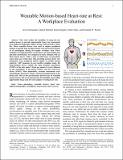Wearable Motion-Based Heart Rate at Rest: A Workplace Evaluation
Author(s)
Hernandez Rivera, Javier; McDuff, Daniel Jonathan; Quigley, Karen; Maes, Patricia; Picard, Rosalind W.
DownloadSubmitted version (1.862Mb)
Terms of use
Metadata
Show full item recordAbstract
IEEE This work studies the feasibility of using low-cost motion sensors to provide opportunistic heart rate assessments from ballistocardiographic signals during restful periods of daily life. Three wearable devices were used to capture peripheral motions at specific body locations (head, wrist and trouser pocket) of 15 participants during five regular workdays each. Three methods were implemented to extract heart rate from motion data and their performance was compared to those obtained with an FDA-cleared device. With a total of 1358 hours of naturalistic sensor data, our results show that providing accurate heart rate estimations from peripheral motion signals is possible during relatively "still" moments. In our real-life workplace study, the head-mounted device yielded the most frequent assessments (22.98% of the time under 5 beats per minute of error) followed by the smartphone in the pocket (5.02%) and the wrist-worn device (3.48%). Most importantly, accurate assessments were automatically detected by using a custom threshold based on the device jerk. Due to the pervasiveness and low-cost of wearable motion sensors, this work demonstrates the feasibility of providing opportunistic large-scale low-cost samples of resting heart rate.
Date issued
2019-09Department
Massachusetts Institute of Technology. Media LaboratoryJournal
IEEE Journal of Biomedical and Health Informatics
Publisher
Institute of Electrical and Electronics Engineers (IEEE)
Citation
Hernandez, Javier et al. "Wearable Motion-Based Heart Rate at Rest: A Workplace Evaluation." IEEE Journal of Biomedical and Health Informatics 23, 5 (September 2019): 1920 - 1927 © 2019 IEEE
Version: Original manuscript
ISSN
2168-2194
2168-2208